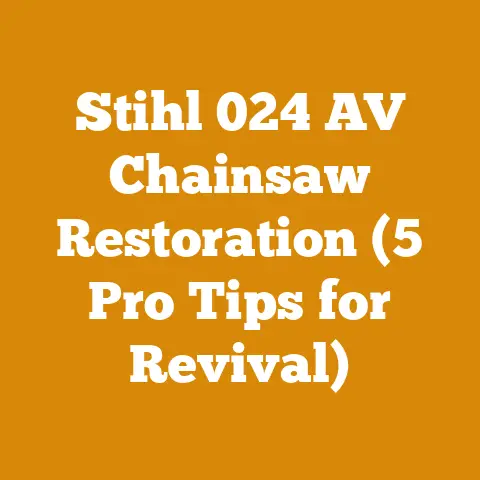How to Hang Lights on Outdoor Trees (7 Pro Arborist Tips)
In recent years, there’s been a growing trend of homeowners and businesses alike adorning outdoor trees with lights, transforming ordinary landscapes into magical, inviting spaces.
From festive holiday displays to year-round ambient lighting, the reasons for this trend are as varied as the lighting styles themselves.
But what I’ve noticed, after years of working with trees and wood, is that the health of the tree is often an afterthought.
People get caught up in the aesthetics and forget that they’re dealing with living organisms.
That’s where my experience comes in.
I’ve spent decades felling, processing, and understanding trees inside and out.
I’ve seen the damage that improper techniques, even seemingly harmless ones like hanging lights, can inflict.
I’m here to share pro arborist tips that not only help you create stunning displays but also ensure the well-being of your cherished trees.
Let’s dive into the art and science of hanging lights on outdoor trees responsibly.
How to Hang Lights on Outdoor Trees: 7 Pro Arborist Tips
1. Understanding Your Trees: The Foundation of Safe Lighting
Before you even think about unwrapping that string of lights, take a good look at the trees you plan to decorate.
Just as I consider the species, age, and health of a tree before felling it, you need to understand these factors before adding any decorations.
- Species Matters: Different tree species have varying bark textures, growth habits, and susceptibility to damage.
For instance, smooth-barked trees like beeches are more prone to injury from abrasion than rough-barked oaks.
Knowing your tree species is the first step in choosing the right hanging method. - Age and Health: Young, developing trees are more vulnerable to damage than mature, established ones.
A stressed or diseased tree is also less resilient and more likely to suffer from the added weight and potential constriction of lights.
I always advise against hanging lights on trees that are already showing signs of decline. - Growth Rate: Fast-growing trees will quickly outgrow any fixed attachments.
What seems like a loose loop today could become a constricting stranglehold in a matter of months.
Personal Story: I once worked on a project where a homeowner had wrapped a young maple tree with Christmas lights.
The tree was only a few years old, and the lights were tightly wound around the trunk.
By the following spring, the lights had begun to girdle the tree, restricting its growth and damaging the bark.
It was a stark reminder of how seemingly innocent decorations can have serious consequences.
Actionable Takeaway: Before hanging any lights, identify your tree species, assess its age and health, and consider its growth rate.
This information will guide your choice of hanging method and help you avoid damaging your trees.
2. Choosing the Right Lights: LEDs Are Your Best Friend
The type of lights you choose can significantly impact your trees’ health.
I always recommend using LED lights for outdoor tree decoration.
Here’s why:
- Low Heat Emission: Unlike traditional incandescent lights, LEDs produce very little heat.
This is crucial because excessive heat can damage bark and foliage, especially on sensitive tree species. - Energy Efficiency: LEDs consume significantly less energy than incandescent lights, reducing your carbon footprint and saving you money on your electricity bill.
- Long Lifespan: LEDs have a much longer lifespan than incandescent lights, meaning you’ll need to replace them less frequently.
This reduces the disturbance to your trees and minimizes the risk of damage during installation and removal. - Durability: LEDs are generally more durable and weather-resistant than incandescent lights, making them a better choice for outdoor use.
Data Point: According to the U.S.
Department of Energy, LEDs use at least 75% less energy and last up to 25 times longer than incandescent lighting.
Actionable Takeaway: Always choose LED lights for outdoor tree decoration.
They are safer for your trees, more energy-efficient, and longer-lasting.
3. Safe Hanging Methods: Prioritizing Tree Health
The way you attach lights to your trees is critical to their health.
Avoid methods that can constrict, abrade, or otherwise damage the bark.
- Avoid Staples, Nails, and Screws: These methods create permanent wounds that can become entry points for pests and diseases.
I’ve seen countless trees suffer from infections and decay caused by poorly placed staples and nails. - Use Wide, Flexible Straps: Opt for wide, flexible straps made of soft materials like fabric or rubber.
These straps distribute the weight of the lights evenly and minimize the risk of constriction.
Make sure they are loose enough to allow for trunk and branch growth. - Consider Zip Ties with Caution: While zip ties can be convenient, they can also become constricting as the tree grows.
If you use zip ties, choose wide, UV-resistant ones and check them regularly to ensure they are not too tight.
Consider using zip ties designed to break under pressure. - Branch Clipping: Use plastic clips designed to gently attach lights to branches.
These clips are easy to install and remove and won’t damage the bark. - Avoid Wrapping Trunks Tightly: Wrapping the trunk of a tree tightly with lights can restrict its growth and damage the bark.
If you want to illuminate the trunk, use loose loops or project light onto the trunk from a distance.
Example: Let’s say you want to hang lights on a young maple tree.
I would recommend using wide, flexible fabric straps to attach the lights to the branches.
Place the straps loosely around the branches, ensuring that there is plenty of room for growth.
Check the straps regularly to make sure they are not too tight.
Actionable Takeaway: Avoid using staples, nails, and screws.
Opt for wide, flexible straps or branch clips.
If you use zip ties, choose wide, UV-resistant ones and check them regularly.
Avoid wrapping trunks tightly.
4. Weight Distribution: Preventing Branch Damage
The weight of the lights can put a strain on tree branches, especially during windy or snowy conditions.
Proper weight distribution is essential to prevent branch damage.
- Distribute Weight Evenly: Spread the weight of the lights evenly across multiple branches.
Avoid concentrating the weight on a single branch. - Use Lightweight Lights: Choose lightweight LED lights to minimize the strain on branches.
- Consider Branch Support: If you are hanging heavy lights on weak or vulnerable branches, consider using branch supports to provide additional support.
Case Study: A local park had decorated a large oak tree with heavy incandescent lights for the holiday season.
The weight of the lights, combined with a heavy snowfall, caused several large branches to break.
The park staff learned a valuable lesson about the importance of weight distribution and switched to lightweight LED lights the following year.
Actionable Takeaway: Distribute the weight of the lights evenly across multiple branches.
Use lightweight LED lights.
Consider branch support for weak or vulnerable branches.
5. Timing is Everything: Seasonal Considerations
The timing of your lighting display can also impact your trees’ health.
- Avoid Prolonged Lighting: Continuous lighting can disrupt a tree’s natural dormancy cycle, especially during the winter months.
I recommend limiting the duration of your lighting display to a few hours each evening. - Remove Lights Promptly: Remove the lights as soon as the season is over.
Leaving them on for extended periods can increase the risk of constriction and damage. - Consider Tree Dormancy: Avoid hanging or removing lights during the tree’s active growing season (spring and summer).
This is when the tree is most vulnerable to damage.
Personal Story: I once saw a homeowner leave Christmas lights on a pine tree year-round.
The lights were so tightly wound around the branches that they had begun to girdle the branches, causing them to die back.
It was a sad sight and a clear example of the importance of removing lights promptly.
Actionable Takeaway: Avoid prolonged lighting.
Remove lights promptly after the season is over.
Avoid hanging or removing lights during the tree’s active growing season.
6. Regular Inspection: Catching Problems Early
Regular inspection is crucial for identifying and addressing any potential problems before they become serious.
- Check for Constriction: Regularly inspect the straps, zip ties, or clips to ensure they are not constricting the tree’s growth.
Loosen or remove them as needed. - Look for Damage: Check the bark for any signs of abrasion, cracking, or other damage.
Address any damage promptly to prevent infection. - Monitor Tree Health: Keep an eye on the overall health of the tree.
Look for signs of stress, such as yellowing leaves, wilting branches, or stunted growth.
Consult with a certified arborist if you notice any concerning symptoms.
Data Point: Studies have shown that early detection and treatment of tree problems can significantly improve their chances of survival.
Actionable Takeaway: Regularly inspect the straps, zip ties, or clips for constriction.
Look for any signs of bark damage.
Monitor the overall health of the tree.
7. Professional Consultation: When in Doubt, Ask an Expert
If you are unsure about any aspect of hanging lights on your trees, consult with a certified arborist.
An arborist can assess the health of your trees, recommend appropriate hanging methods, and provide guidance on how to minimize the risk of damage.
- Arborist Expertise: Arborists have the knowledge and experience to assess the health of your trees and identify any potential problems.
- Customized Recommendations: An arborist can provide customized recommendations based on the specific needs of your trees.
- Peace of Mind: Consulting with an arborist can give you peace of mind knowing that you are taking the best possible care of your trees.
Real-World Scenario: A homeowner was planning to hang a large number of lights on a mature oak tree.
Concerned about the potential impact on the tree’s health, they consulted with a certified arborist.
The arborist advised them to use lightweight LED lights, distribute the weight evenly across multiple branches, and avoid wrapping the trunk tightly.
By following the arborist’s recommendations, the homeowner was able to create a beautiful lighting display without harming the tree.
Actionable Takeaway: If you are unsure about any aspect of hanging lights on your trees, consult with a certified arborist.
Wood Processing Insights: A Logger’s Perspective
My background in logging and wood processing has given me a unique perspective on tree health and the potential impact of human activities.
I’ve seen firsthand the damage that can be caused by improper logging practices, and I’ve learned the importance of sustainable forestry management.
One of the key things I’ve learned is that every tree is different.
Just like people, trees have their own unique characteristics and vulnerabilities.
Some trees are more resilient than others, while others are more susceptible to disease and damage.
That’s why it’s so important to understand your trees before you start hanging lights on them.
Another important lesson I’ve learned is that prevention is always better than cure.
It’s much easier to prevent damage to a tree than it is to repair it after the fact.
By following the tips I’ve shared in this article, you can minimize the risk of damage and ensure the health and longevity of your trees.
Firewood Preparation: A Parallel to Tree Care
Firewood preparation, while seemingly unrelated, shares a common thread with tree care: respect for the wood and understanding its properties.
Just as I carefully select the right tools and techniques for felling and processing trees, you need to choose the right methods for hanging lights.
- Wood Species and Burning Qualities: Different wood species have different burning qualities.
Similarly, different tree species react differently to the stress of having lights attached. - Seasoning and Drying: Proper seasoning and drying are essential for firewood to burn efficiently.
Similarly, proper care and maintenance are essential for trees to thrive. - Tool Selection and Safety: Choosing the right tools and following safety precautions are crucial for firewood preparation.
Similarly, choosing the right hanging methods and prioritizing tree health are crucial for hanging lights.
Example: Just as I wouldn’t use a dull chainsaw to fell a tree, you shouldn’t use staples or nails to hang lights on a tree.
Both are inefficient and potentially damaging.
Conclusion: A Harmonious Blend of Beauty and Responsibility
Hanging lights on outdoor trees can transform your landscape into a magical wonderland.
However, it’s crucial to do so responsibly, prioritizing the health and well-being of your trees.
By following these pro arborist tips, you can create stunning displays without harming your cherished trees.
Remember, trees are living organisms that deserve our respect and care.
By understanding their needs and following best practices, we can enjoy their beauty for years to come.
So, go ahead and light up your trees, but do it with knowledge, care, and a deep appreciation for the natural world.
Your trees will thank you for it.
And who knows, maybe you’ll even inspire your neighbors to do the same, creating a community-wide celebration of light and nature.
Now, that’s a trend I can get behind!






